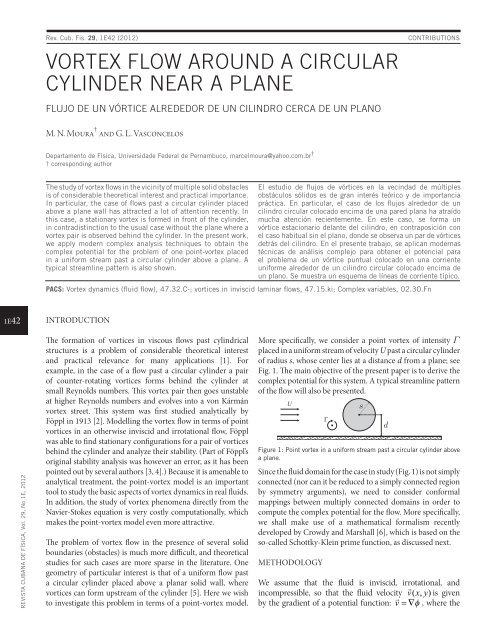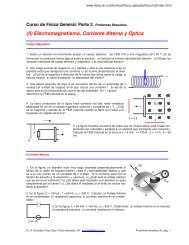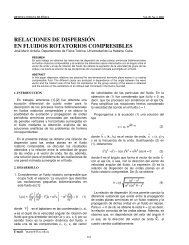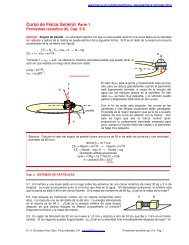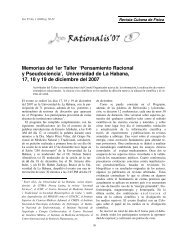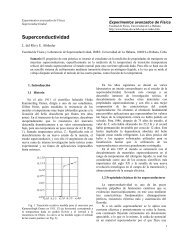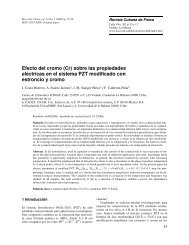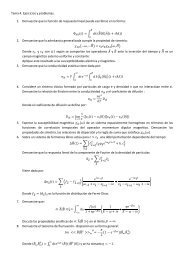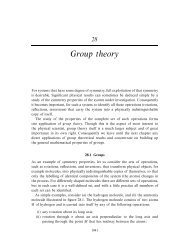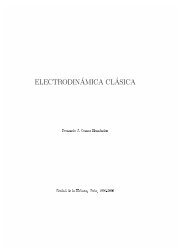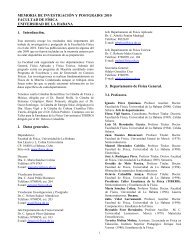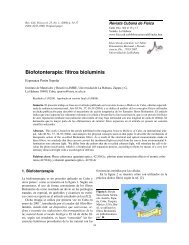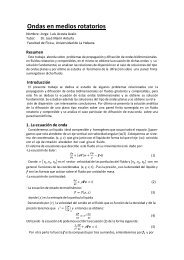VORTEX FLOW AROUND A CIRCULAR ... - Facultad de FÃsica
VORTEX FLOW AROUND A CIRCULAR ... - Facultad de FÃsica
VORTEX FLOW AROUND A CIRCULAR ... - Facultad de FÃsica
You also want an ePaper? Increase the reach of your titles
YUMPU automatically turns print PDFs into web optimized ePapers that Google loves.
Rev. Cub. Fis. 29, 1E42 (2012)<br />
<strong>VORTEX</strong> <strong>FLOW</strong> <strong>AROUND</strong> A <strong>CIRCULAR</strong><br />
CYLINDER NEAR A PLANE<br />
FLUJO DE UN VÓRTICE ALREDEDOR DE UN CILINDRO CERCA DE UN PLANO<br />
CONTRIBUTIONS<br />
M. N. Moura † and G. L. Vasconcelos<br />
Departamento <strong>de</strong> Fìsica, Universida<strong>de</strong> Fe<strong>de</strong>ral <strong>de</strong> Pernambuco, marcelmoura@yahoo.com.br †<br />
† corresponding author<br />
The study of vortex flows in the vicinity of multiple solid obstacles<br />
is of consi<strong>de</strong>rable theoretical interest and practical importance.<br />
In particular, the case of flows past a circular cylin<strong>de</strong>r placed<br />
above a plane wall has attracted a lot of attention recently. In<br />
this case, a stationary vortex is formed in front of the cylin<strong>de</strong>r,<br />
in contradistinction to the usual case without the plane where a<br />
vortex pair is observed behind the cylin<strong>de</strong>r. In the present work,<br />
we apply mo<strong>de</strong>rn complex analysis techniques to obtain the<br />
complex potential for the problem of one point-vortex placed<br />
in a uniform stream past a circular cylin<strong>de</strong>r above a plane. A<br />
typical streamline pattern is also shown.<br />
El estudio <strong>de</strong> flujos <strong>de</strong> vórtices en la vecindad <strong>de</strong> múltiples<br />
obstáculos sólidos es <strong>de</strong> gran interés teórico y <strong>de</strong> importancia<br />
práctica. En particular, el caso <strong>de</strong> los flujos alre<strong>de</strong>dor <strong>de</strong> un<br />
cilindro circular colocado encima <strong>de</strong> una pared plana ha atraído<br />
mucha atención recientemente. En este caso, se forma un<br />
vórtice estacionario <strong>de</strong>lante <strong>de</strong>l cilindro, en contraposición con<br />
el caso habitual sin el plano, don<strong>de</strong> se observa un par <strong>de</strong> vórtices<br />
<strong>de</strong>trás <strong>de</strong>l cilindro. En el presente trabajo, se aplican mo<strong>de</strong>rnas<br />
técnicas <strong>de</strong> análisis complejo para obtener el potencial para<br />
el problema <strong>de</strong> un vórtice puntual colocado en una corriente<br />
uniforme alre<strong>de</strong>dor <strong>de</strong> un cilindro circular colocado encima <strong>de</strong><br />
un plano. Se muestra un esquema <strong>de</strong> líneas <strong>de</strong> corriente típico.<br />
PACS: Vortex dynamics (fluid flow), 47.32.C-; vortices in inviscid laminar flows, 47.15.ki; Complex variables, 02.30.Fn<br />
1E42<br />
INTRODUCTION<br />
REVISTA CUBANA DE FÍSICA, Vol. 29, No 1E, 2012<br />
The formation of vortices in viscous flows past cylindrical<br />
structures is a problem of consi<strong>de</strong>rable theoretical interest<br />
and practical relevance for many applications [1]. For<br />
example, in the case of a flow past a circular cylin<strong>de</strong>r a pair<br />
of counter-rotating vortices forms behind the cylin<strong>de</strong>r at<br />
small Reynolds numbers. This vortex pair then goes unstable<br />
at higher Reynolds numbers and evolves into a von Kármán<br />
vortex street. This system was first studied analytically by<br />
Föppl in 1913 [2]. Mo<strong>de</strong>lling the vortex flow in terms of point<br />
vortices in an otherwise inviscid and irrotational flow, Föppl<br />
was able to find stationary configurations for a pair of vortices<br />
behind the cylin<strong>de</strong>r and analyze their stability. (Part of Föppl’s<br />
original stability analysis was however an error, as it has been<br />
pointed out by several authors [3, 4].) Because it is amenable to<br />
analytical treatment, the point-vortex mo<strong>de</strong>l is an important<br />
tool to study the basic aspects of vortex dynamics in real fluids.<br />
In addition, the study of vortex phenomena directly from the<br />
Navier-Stokes equation is very costly computationally, which<br />
makes the point-vortex mo<strong>de</strong>l even more attractive.<br />
The problem of vortex flow in the presence of several solid<br />
boundaries (obstacles) is much more difficult, and theoretical<br />
studies for such cases are more sparse in the literature. One<br />
geometry of particular interest is that of a uniform flow past<br />
a circular cylin<strong>de</strong>r placed above a planar solid wall, where<br />
vortices can form upstream of the cylin<strong>de</strong>r [5]. Here we wish<br />
to investigate this problem in terms of a point-vortex mo<strong>de</strong>l.<br />
More specifically, we consi<strong>de</strong>r a point vortex of intensity C<br />
placed in a uniform stream of velocity U past a circular cylin<strong>de</strong>r<br />
of radius s, whose center lies at a distance d from a plane; see<br />
Fig. 1. The main objective of the present paper is to <strong>de</strong>rive the<br />
complex potential for this system. A typical streamline pattern<br />
of the flow will also be presented.<br />
U<br />
<br />
Figure 1: Point vortex in a uniform stream past a circular cylin<strong>de</strong>r above<br />
a plane.<br />
Since the fluid domain for the case in study (Fig. 1) is not simply<br />
connected (nor can it be reduced to a simply connected region<br />
by symmetry arguments), we need to consi<strong>de</strong>r conformal<br />
mappings between multiply connected domains in or<strong>de</strong>r to<br />
compute the complex potential for the flow. More specifically,<br />
we shall make use of a mathematical formalism recently<br />
<strong>de</strong>veloped by Crowdy and Marshall [6], which is based on the<br />
so-called Schottky-Klein prime function, as discussed next.<br />
METHODOLOGY<br />
We assume that the fluid is inviscid, irrotational, and<br />
incompressible, so that the fluid velocity vxy<br />
<br />
by the gradient of a potential function: ( , ) is given<br />
v =∇φ , where the<br />
s<br />
d
2<br />
velocity potential φ( xy , ) obeys Laplace equation: ∇ φ = 0 .<br />
Our main goal here is to compute the complex potential<br />
wz ( ) = φ( xy , ) + iψ ( x, y)<br />
, where ψ is the so-called stream<br />
function, for the problem illustrated in Fig. 1. To this end, let<br />
us introduce the conformal mapping z(g) from an annular<br />
region, r 0<br />
< |g| < 1, in the auxiliary complex g-plane onto the<br />
fluid domain in the complex z-plane, where the unit circle<br />
|g| = 1 is mapped to the plane boundary and the inner circle<br />
|g| = r 0<br />
is mapped to the cylin<strong>de</strong>r. Furthermore, the points<br />
g = i and g = -i are mapped to z = 0 and z = 3, respectively;<br />
see Fig. 2.<br />
<br />
1<br />
0<br />
E<br />
H<br />
G<br />
F<br />
v<br />
G<br />
H<br />
E<br />
0<br />
Figure 2: Circular domain in the auxiliary complex g-plane (left) and<br />
physical domain in the complex z-plane (right).<br />
It is not difficult to see that the function that enacts the <strong>de</strong>sired<br />
mapping is given by<br />
2 2 ⎛ ζ − i ⎞<br />
z( ζ ) =−i d − s ⎜ ⎟,<br />
(1)<br />
⎝ ζ + i ⎠<br />
whose inverse is<br />
ζ ( z) i z i d 2 s 2<br />
− −<br />
=−<br />
.<br />
2 2<br />
z+ i d −s<br />
(2)<br />
The radius r 0<br />
of the inner circle in the g-plane is related to the<br />
physical parameters s and d by the following expression:<br />
r<br />
0<br />
1<br />
= − 1 +<br />
d−s<br />
d+<br />
s<br />
d−s<br />
d+<br />
s<br />
as can be easily verified.<br />
, (3)<br />
F<br />
cylin<strong>de</strong>r surface be a streamline of the flow.<br />
For the geometry shown in Fig. 1, where in addition to the<br />
cylin<strong>de</strong>r there is an extra boundary (the plane y = 0), the<br />
circle theorem is no longer of help, and one has to resort to<br />
an alternative approach in or<strong>de</strong>r to compute the contribution<br />
from the infinite set of vortex images (both insi<strong>de</strong> the cylin<strong>de</strong>r<br />
and below the plane). In this case, it is more convenient to<br />
compute the complex potential in the auxiliary g-plane and<br />
then transform it back to the z-plane. In<strong>de</strong>ed, it can be shown<br />
[6, 9] that for a point vortex of unit intensity, located at position<br />
g = a in a circular domain in the g-plane, the complex potential<br />
w v<br />
(g,a) is given by<br />
w ( , ) 1<br />
v<br />
i<br />
log ⎡ ωζ ( , α)<br />
⎤<br />
ζα = ⎢ ⎥,<br />
1<br />
(6)<br />
2π<br />
⎣⎢<br />
αω( ζ , α ) ⎦⎥<br />
where ~(g,a) is the so-called Schottky-Klein prime function,<br />
which enco<strong>de</strong>s the geometry of the circular domain.<br />
For the particular geometry shown in Fig. 2, the Schottky-Klein<br />
prime function ~(g,a) can be expressed in a simple form:<br />
α ⎛ ζ ⎞<br />
ωζ ( , α) =− ⎜ , ⎟,<br />
C P ⎝ α<br />
r 0<br />
⎠<br />
where<br />
∞<br />
(<br />
2<br />
r n<br />
)<br />
n=<br />
1<br />
C = ∏ 1 −<br />
0<br />
and<br />
∞<br />
∏( )( − )<br />
2n<br />
2n<br />
−1 Pxy ( , ) = ( 1−x) 1−<br />
y x 1 y x .<br />
(9)<br />
n=<br />
1<br />
From the <strong>de</strong>finition of the complex potential w v<br />
(g,a) given<br />
in Eqs. (6)-(9), one can verify that it satisfies the appropriate<br />
boundary conditions in the g-plane, namely, that the unit<br />
circle and the inner circle are both streamlines of the flow.<br />
(7)<br />
(8)<br />
1E43<br />
Before presenting the complex potential for the problem<br />
above, it is instructive to recall [7] that the complex potential<br />
for a point vortex of intensity C located at position z = z v<br />
(in an<br />
unboun<strong>de</strong>d domain) is given by<br />
Γ<br />
wz ( ) = log ( z−z v ).<br />
2π i<br />
Similarly, for a vortex in the presence of a cylin<strong>de</strong>r of radius a,<br />
the complex potential can be easily obtained by virtue of the<br />
Milne-Thomson circle theorem [8], which yields<br />
Γ ⎡ z−<br />
z ⎤<br />
v<br />
wz ( ) = log ⎢ .<br />
2 ⎥<br />
2π i ⎣ z−<br />
a / zv<br />
⎦<br />
(5)<br />
Here the term in the numerator comes from the contribution<br />
to the complex potential from the vortex itself, see Eq. (4);<br />
whereas the term in the <strong>de</strong>nominator corresponds to the<br />
contribution from the vortex image (insi<strong>de</strong> the cylin<strong>de</strong>r),<br />
which is necessary to enforce the boundary condition that the<br />
(4)<br />
The function P(x,y) given in Eq. (9) is related to the first Jacobi<br />
theta function j 1<br />
, which appears in the theory of elliptic<br />
functions [10]. In<strong>de</strong>ed, it is possible to <strong>de</strong>rive an expression for<br />
the complex potential w v<br />
(g,a) entirely within the framework<br />
of elliptic functions. The advantage of the method based on the<br />
Schottky-Klein prime function is that it can be rather easily<br />
exten<strong>de</strong>d to two-dimensional vortex flows around an arbitrary<br />
number of obstacles. (This general problem is however beyond<br />
the scope of the present work.)<br />
Using the complex potential for a vortex of unit intensity given<br />
in Eq. (6), it is possible to obtain the complex potential, w U<br />
(z),<br />
due to a uniform stream of velocity U past a cylin<strong>de</strong>r above<br />
a plane (with no other flow elements). In this case, it can be<br />
shown [11] that the corresponding complex potential, w U<br />
(g),<br />
in the g-plane is given by<br />
∂wv<br />
wv<br />
wU<br />
( ζ) =− πUi d − s − ∂ 2 2 ⎛ ⎞<br />
2<br />
⎜<br />
,<br />
⎝ ∂α ∂α ⎟<br />
(10)<br />
⎠ α =−i<br />
REVISTA CUBANA DE FÍSICA, Vol. 29, No 1E, 2012
1E44<br />
REVISTA CUBANA DE FÍSICA, Vol. 29, No 1E, 2012<br />
with w v<br />
as in Eq. (6). Notice that the <strong>de</strong>rivatives in Eq. (10) are<br />
evaluated at the point a = -i, which is the point that is mapped<br />
to infinity by the conformal map z(g), i.e., z(-i) = 3. In the<br />
next section we shall use Eqs. (10) and (6) to construct the<br />
complex potential for the vortex flow illustrated in Fig. 1.<br />
RESULTS AND DISCUSSION<br />
The complex potential w(z) for the problem of a vortex of<br />
intensity C placed at position z v<br />
in a uniform stream in the<br />
presence of a cylin<strong>de</strong>r and a plane boundary can be obtained<br />
by combining Eq. (10) with Eq. (6), multiplied by C. This yields<br />
wz ( ) = w ( ζ( z)) + Γ w ( ζ( z), ζ ( z )),<br />
(11)<br />
U v v<br />
where g(z) is the inverse mapping given in Eq. (2). As is well<br />
known [7], the velocity field v<br />
= ( u, v) can be found by simply<br />
taking the <strong>de</strong>rivative of the complex potential:<br />
dw<br />
u− iv = . (12)<br />
dz<br />
This yields a pair of differential equations for x= u( xy , ) and<br />
y = v( xy , ) , which can be numerically integrated to generate<br />
the flow streamlines. It is however more convenient to take<br />
an alternative approach, namely, perform a contour plot of<br />
the stream function ψ ( xy , ) , which can be easily obtained<br />
by taking the imaginary part of the complex potential (11).<br />
Each level set ψ ( xy , ) = c, with c being a constant, then yields<br />
a streamline of the flow. Figure 3 shows the streamline pattern<br />
obtained from the contour plot just <strong>de</strong>scribed for the case<br />
when U = 1, C= -10, and the vortex is located at z v<br />
=-1.5 + 0.5i.<br />
Figure 3: Streamline pattern for the flow studied. The parameters chosen<br />
are C= -10, U = 1, and z v<br />
=-1.5 + 0.5i.<br />
The streamline pattern shown in Fig. 3 displays some<br />
interesting features. Of particular interest is the formation of<br />
a recirculation zone around the vortex in front of the cylin<strong>de</strong>r.<br />
A pattern similar to this was seen in the experiments on flows<br />
past a circular cylin<strong>de</strong>r above a plane reported in Ref. [5].<br />
Notice that the recirculation zone acts as an “obstacle” to the<br />
oncoming flow, <strong>de</strong>flecting part of the fluid over the top of<br />
the cylin<strong>de</strong>r and thus reducing the flow though the gap. Note<br />
also that far above from the cylin<strong>de</strong>r the streamlines tend to<br />
be straight lines, meaning that far away from the cylin<strong>de</strong>r one<br />
recovers the uniform flow imposed by the uniform stream, as<br />
expected.<br />
CONCLUSIONS<br />
We computed the complex potential w(z) for a point vortex<br />
in a uniform stream past a circular cylin<strong>de</strong>r placed above a<br />
plane wall. From the imaginary part of w(z), we obtained<br />
the stream function of the flow whose level sets yield the<br />
streamlines. In particular, we presented the streamline pattern<br />
for the case when the vortex is placed upstream of the cylin<strong>de</strong>r<br />
—a situation that is of interest to the experiments on viscous<br />
flows past a cylin<strong>de</strong>r above a plane recently performed by Lin<br />
et al. [5]. The next step towards a more complete theoretical<br />
un<strong>de</strong>rstanding of the system is to study the vortex dynamics<br />
in this geometry, by allowing the vortex to move with the flow<br />
velocity (excluding the vortex own contribution) at the vortex<br />
position. This analysis is currently in progress.<br />
ACKNOWLEDGMENTS<br />
This work was supported in part by the Brazilian agencies<br />
CNPq and FACEPE.<br />
[1] B. M. Sumer and J. Fredse, Hydrodynamics around<br />
cylindrical structures (World Scientific, Singapore, 2006).<br />
[2] L. Föppl, Sitzb. Bayer. Akad. Wiss. 1, 1 (1913).<br />
[3] S. Tang and N. Aubry, Phys. Fluids 9, 2550 (1997).<br />
[4] G. L. Vasconcelos, M. N. Moura, and A. M. J. Schakel, Phys.<br />
Fluids 23, 123601 (2011).<br />
[5] W. J. Lin, C. Lin, S. C. Hsieh, and S. Dey, J. Eng. Mech. 135,<br />
697 (2009).<br />
[6] D. G. Crowdy and J. S. Marshall, Proc. R. Soc. A. 461, 2477<br />
(2005).<br />
[7] P. G. Saffman, Vortex Dynamics (Cambridge University<br />
Press, Cambridge, 1992).<br />
[8] L. M. Milne-Thomson, Theoretical Hydrodynamics (Dover,<br />
New York, 1996).<br />
[9] D. G. Crowdy, Theor. Comput. Fluid Dyn. 24, 9 (2010).<br />
[10] D. G. Crowdy and J. S. Marshall, Phys. Fluids 17, 056602<br />
(2005).<br />
[11] M. N. Moura, “Vortex motion around a circular cylin<strong>de</strong>r<br />
both in an unboun<strong>de</strong>d domain and near a plane boundary,”<br />
Master’s thesis, Fe<strong>de</strong>ral University of Pernambuco, 2012.


